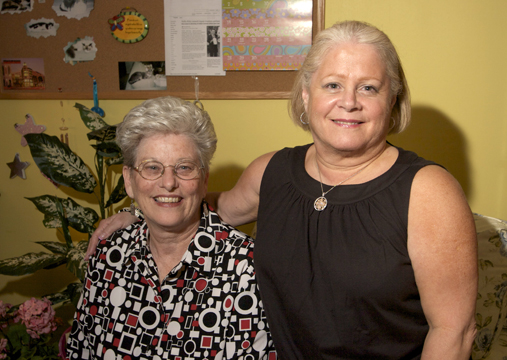Burnam wants some TIF money for downtown worker bees and their kids.
By DAN MCGRAW
Two months ago, Downtown Fort Worth Inc., the nonprofit that works on behalf of central-city businesses, surveyed area workers about whether they would use daycare programs close to their jobs. The results were surprising to many: A large fraction of workers, from wait staffers to white-collar types, said they need some kind of downtown child care help.
In the office worker category, 20 percent of those surveyed said they needed full-time daycare options and another six percent said they would use after-school care downtown if it was available.
In the retail and hospitality industries, the need was much larger. About 55 percent said they would use some kind of downtown daycare – full-time, nights, after school, or a couple of days a week.
The findings were based on 382 people who returned the surveys. If the results hold true (with a five percent margin of error assumed in either direction), it could mean that almost 6,000 downtown workers are looking for full-time care for their kids, and almost 1,800 need after-school care placements.
State Rep. Lon Burnam has long been pushing for downtown programs that benefit more than just the rich business interests, and he’s now calling for some taxpayer subsidies to increase daycare options. The longtime Democratic legislator wants to use money from the downtown tax increment finance district (TIF) to help fund those programs.
“The TIF board has long given big payouts for economic development to the rich and nothing much in programs for the working poor,” said Burnam, a member of the TIF board. “As it stands now, we are baking a big pie for the downtown business interests, and they eat most of it. Working parents get only a few crumbs.”
When the TIF downtown board met two weeks ago to approve the annual budget, Burnam was the only member voting against it. Instead, he called on the board to set aside $1 million to develop daycare programs. That would be “a drop in the budget for this TIF, and I am not going to be quiet until this gets acted upon,” he said.
Created in 1993, the downtown tax district gets its funding from the increase in city tax dollars within the district, based on growth in property values. TIF spending – capped at $5 million a year – is supposed to go for infrastructure projects to support economic development. Nearly 80 percent of it, or about $3.1 million in the coming fiscal year, will be used to underwrite free parking. Most of the rest will be held as a surplus, a pot that is projected to top $12 million within the next decade.
The TIF board has appointed a subcommittee to study future programs, including the daycare option. Fort Worth City Council member Joel Burns, who heads the subcommittee, said it’s premature to say whether some of that money should be used to underwrite daycare programs, and he’s asked city attorneys whether that kind of spending would be legal. “I’ve asked our legal department to give us a heads up on whether this fits in with what the TIF is designed to do,” he said.
State law regulating the uses of TIF money is vague enough that providing multi-million-dollar tax incentives for a “blighted” area like Alliance Airport (via a subsidy for the Cabela’s megastore by another TIF), was ruled legal. But the key limitation in this case is what has been adopted as the downtown TIF’s “project plan.” Any change to that plan, according to state law, must be done by city ordinance.
Peter Vaky, the assistant city attorney who advises the downtown TIF board, did not return calls for comment on this story. But several people familiar with the situation said that adding daycare spending to the TIF plan would require approval of the city council, the school board, Tarrant County commissioners, and the county college district.
Burnam believes that money for downtown daycare could be legally approved without “jumping through all these hoops.” He said the $1 million he has proposed “is not an annual expenditure, but the entire cost. We have the surplus, and we can use a part of that to fund the project and still not go over the $5 million cap.”
Andy Taft, president of Downtown Fort Worth Inc., which oversees the downtown TIF, also said it’s too soon to say whether daycare funding is a good investment.
“It is a social need that seems to be very apparent, as child care for our downtown workers is important and makes life more convenient and easier,” he said. But, he added, “any downtown daycare is going to be very expensive because of the price of property. There are market issues at play, as well as determining whether this will just pay for the infrastructure, or possibly [be combined with] subsidies for lower-income users.”
Nasser Haghighat, director of research for Downtown Fort Worth Inc., said that the survey results don’t predict 10,000 customers for new downtown daycare, but simply were an expression of interest in the possibility.
Despite the survey results, not all downtown daycare efforts have been successful. RadioShack used to offer the service for children of its headquarters employees, but the program was cut a few years ago for budget reasons and a lack of users.
The Fort Worth school district began a program for downtown workers three years ago at Charles E. Nash Elementary on Samuels Avenue just northeast of downtown. The program – which includes after-school care – allows anyone in the city to enroll their kids at Nash. Principal Pamela Day said “just a handful, probably less than 10 students” use the program. “We don’t have as many as I thought we would, and I’m not sure why,” she said.
The downtown YMCA has a program that closes at 7 p.m. each evening, with capacity for 102 children. Costs range from $120 to $135 per week, but financial assistance is available. “Certain ages have waiting lists,” said Sue Yaker, director of child care services for the YMCA, “and we do have to turn people away if some of those ages are filled up.”
But Burnam is convinced the need is there. “The survey says people will take advantage of this service if it is offered,” he said. “Downtown businesses are growing, but we need to give some services to the working-class people who make that happen.
“We give more than $3 million a year to the developers who own parking garages so that people with enough money to pay for parking can go out to eat at an expensive restaurant or to a show at Bass Hall,” he said. “But I think we need to do more for the people who wait those tables or cook the food or take the tickets. They are telling us we should have more downtown daycare options, and I think we have the money to do it.”










